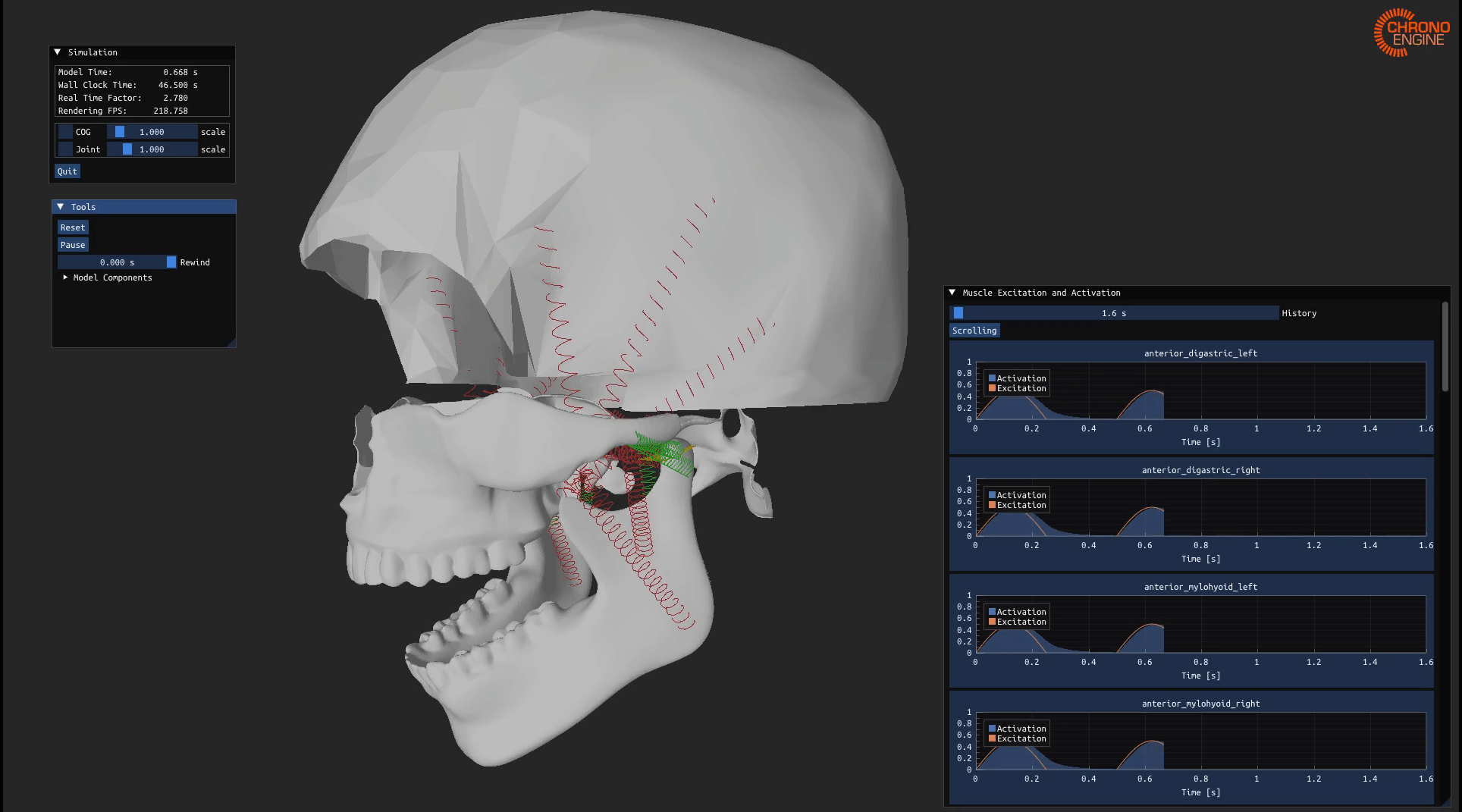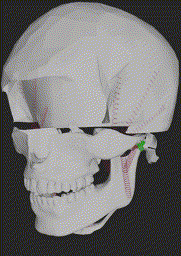ExoSim
An extension to the Chrono Project library for simulating biomechanical systems and exoskeletons.
ExoSim is an open-source extension of the Project Chrono multi-physics simulation engine designed for simulating biomechanical systems and exoskeletons. The primary focus is on human jaw simulation, providing a foundation for developing jaw exoskeletons for treating temporomandibular disorders (TMDs).

Abstract
Temporomandibular disorders affect a significant portion of the population, often causing pain and restricted jaw movement. Physiotherapy with active jaw exoskeletons seems to be a promising treatment approach. However, there has been limited progress in this area, with only a few studies published. The lack of detailed simulations and biomechanical jaw models in these papers impedes the design and validation of such devices.
This work presents an open-source and extendable jaw model framework to support the development of jaw exoskeletons for TMD rehabilitation. By abstracting the model parameters and components to JSON files, the simulation can be more easily configured, extended, and adapted to different individuals and applications.
Framework Architecture
Three Model Variants
The framework includes three jaw model variants with varying complexity levels, each designed for specific use cases:
1. Basic Rigid Body Model with Point-on-Surface Constraints
- Purpose: General motion analysis, kinematics, and rapid prototyping of jaw exoskeletons
- TMJ Modeling: Point-on-surface constraints approximating anatomical paths
- Performance: Real-time capability with $1 \, \mathrm{ms}$ time steps
- Use Case: Fast motion analysis and controller design testing
2. Rigid Body Model with Natural Geometries
- Purpose: More realistic contact modeling and rough TMJ force estimates
- TMJ Modeling: Natural bone mesh constraints for anatomically accurate movement
- Performance: Approximately $40$ times slower than real-time
- Use Case: Improved accuracy while maintaining computational efficiency
3. Hybrid Model with FEM Discs
- Purpose: Detailed analysis of exoskeleton effects on the masticatory system
- TMJ Modeling: Finite element method for viscoelastic articular discs
- Performance: Approximately $2000$ times slower than real-time
- Use Case: Comprehensive biomechanical analysis and validation
Mathematical Framework
Model Components
All models include anatomically accurate representations of:
- Bones: Mandible, maxilla, hyoid, and cranium as rigid bodies
- Muscles: $24$ muscles with force-length and force-velocity dependencies
- Ligaments: $8$ ligaments based on Blankevoort-Huiskes model for joint stabilization
- Novel Feature: Superior head of lateral pterygoid muscle connection to TMJ discs
Muscle Models
The framework implements multiple muscle models:
- Millard et al. muscle model with realistic force-velocity relationships
- Peck et al. model for jaw-specific muscle behavior
TMJ Disc Modeling (Hybrid Model)
The finite element articular discs are:
- Generated by taking imprints between mandibular condyles and fossae
- Converted to tetrahedral volume meshes using fTetWild
- Connected via ligaments to articular fossae and condyles
- Modeled with viscoelastic material properties
Configuration System
JSON-Based Customization
The framework uses four main configuration files for easy model customization:
-
jaw.json: General jaw simulation parameters -
muscles.json: Muscle-specific properties and attachments -
ligaments.json: Ligament parameters and constraints -
fea.json: Finite element analysis settings for articular discs
This abstraction allows researchers to modify model parameters without extensive programming knowledge.
Experimental Validation
Study Design
The framework was evaluated using experimental kinematic data from a single participant (Ethics approval: TU Darmstadt EK $3/2025$). Jaw movements were captured using a Qualisys Oqus motion capture system at $200 \, \mathrm{Hz}$.
Motion Tracking Setup
- Mandibular tracking: $3$D-printed mouthpiece with reflective markers
- Reference frame: Marker headpiece for head motion compensation
- Calibration: Six anatomical landmarks (three mandibular, three maxillary)
Recorded Movements
- Opening and closing motions
- Protrusion and retrusion
- Lateral movements
- Cyclic chewing patterns
Control and Optimization
PID Controller Framework
Muscle excitations were determined using:
- Individual PID controllers for each of the $24$ muscles
- Two-step optimization process: Target muscle length determination followed by controller parameter tuning
- Global optimization: $72$-dimensional problem solved using Pagmo library with self-adaptive differential evolution
Objective Function
The optimization minimizes:
\[J = \sum_{i=0}^{N} \left[ \alpha \| \mathbf{q}_{\text{observed},i} - \mathbf{q}_{\text{simulated},i} \|^2_2 + \beta \| \mathbf{u}_i \|^2_2 + \gamma \| \dot{\mathbf{u}}_i \|^2_2 \right]\]where:
- \(\mathbf{q}_{\text{observed,i}}\) and \(\mathbf{q}_{\text{simulated,i}}\): observed and simulated mandible poses
- $\mathbf{u}$: muscle excitations, $\dot{\mathbf{u}}$: muscle excitation derivatives
- $\alpha = 1$, $\beta = 0.1$, $\gamma = 0.1$: weighting factors
Performance Results
Validation Metrics
| Model Variant | Chewing MAE | Open/Close MAE | Lateral MAE | Protr./Retr. MAE |
|---|---|---|---|---|
| Point-on-Surface | $2.08 \, \mathrm{mm}$ | $2.89 \, \mathrm{mm}$ | $1.56 \, \mathrm{mm}$ | $1.33 \, \mathrm{mm}$ |
| Mesh Geometry | $3.46 \, \mathrm{mm}$ | $4.89 \, \mathrm{mm}$ | $2.75 \, \mathrm{mm}$ | $2.99 \, \mathrm{mm}$ |
| Hybrid FEM | $9.01 \, \mathrm{mm}$ | $10.40 \, \mathrm{mm}$ | $2.91 \, \mathrm{mm}$ | $3.09 \, \mathrm{mm}$ |
MAE: Mean Absolute Error
Computational Performance
- Point-on-Surface Model: Real-time capability
- Mesh Geometry Model: $\sim40\times$ slower than real-time
- Hybrid FEM Model: $\sim2000\times$ slower than real-time
Clinical Applications
TMD Rehabilitation
- Exoskeleton prototyping and validation without human trials
- Safety assessment through biomechanical analysis
- Treatment planning with patient-specific models
Research Applications
- Controller design and testing for rehabilitation devices
- Biomechanical studies of normal vs. pathological jaw function
- Neurological feedback systems for trajectory-tracking training
Educational Use
- Teaching tool for jaw biomechanics and movement patterns
- Visualization platform for complex masticatory system interactions
- Research training in biomechanical modeling techniques
Technical Specifications
Software Requirements
- Language: C++17 or later
- Simulation Engine: Project Chrono multi-physics library
- Optimization: Pagmo library for global optimization
- Mesh Processing: fTetWild for tetrahedral mesh generation
- 3D Modeling: Blender for bone mesh processing
Hardware Requirements
- Minimum: Standard desktop computer for basic models
- Recommended: High-performance computing for hybrid models
- Tested on: Intel i7-13700HX ($24$ cores), $32 \, \mathrm{GB}$ RAM, Ubuntu $22.04.5$ LTS
File Formats
- Configuration: JSON files for easy parameter modification
- 3D Models: STL and Blender formats for bone geometries
- Output: Standard formats compatible with analysis tools
Installation and Usage
Quick Start
# Clone repository
git clone https://github.com/paulotto/exosim.git
# Follow installation instructions
cd exosim/scripts/install
./install_ubuntu.sh
# Build and run example
mkdir build && cd build
cmake .. && make
./jaw_model
Configuration
Modify the JSON files in resources/json/ to customize:
- Muscle properties and attachments
- Ligament parameters
- Simulation settings
- FEA material properties
Future Development
Technical Enhancements
- Optimization framework for automated muscle activation generation
- Patient-specific modeling from MRI/CT data
- Enhanced anatomical detail including TMJ capsules and cartilage
Clinical Translation
- Exoskeleton design tools integrated into the framework
- Control system development utilities
- Validation studies with larger patient cohorts
Research Extensions
- Machine learning integration for automated modeling
- Virtual reality interfaces for immersive analysis
- Cloud computing support for large-scale simulations
Licensing and Availability
Open Source License
- Source Code: GNU General Public License v3.0 or later
- 3D Models: Creative Commons Attribution 4.0 International (CC BY 4.0)
- Third-party Libraries: Various licenses (Project Chrono: BSD-3, spline: GPL v2)
Repository Access
GitHub: https://github.com/paulotto/exosim
- Documentation: Comprehensive installation guides and usage examples
- Models: 3D printable components and Blender project files
- Examples: Sample configurations and validation datasets
Citation
@INPROCEEDINGS{Mueller2025,
author={Müller, Paul-Otto and von Stryk, Oskar},
booktitle={2025 IEEE International Conference on Simulation, Modeling, and Programming for Autonomous Robots (SIMPAR)},
title={The Foundation for Developing an Exoskeleton for the Rehabilitation of Temporomandibular Disorders},
year={2025},
pages={1-6},
keywords={Accuracy;Computational modeling;Biological system modeling;Exoskeletons;Predictive models;Muscles;Programming;Rapid prototyping;Data models;Optimization;exoskeletons;jaw model;temporomandibular disorders;rehabilitation;framework},
url={https://ieeexplore.ieee.org/abstract/document/10979121},
doi={10.1109/SIMPAR62925.2025.10979121}
}
Authors and Acknowledgment
- Paul-Otto Müller, Simulation, Systems Optimization and Robotics Group, TU Darmstadt
- Oskar von Stryk, Simulation, Systems Optimization and Robotics Group, TU Darmstadt
Funding: Optimization calculations conducted on the Lichtenberg high-performance computer of TU Darmstadt.
